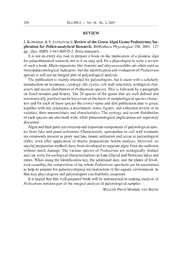
Review PDF
Preview Review
288 BLUMEA — Vol. 48, No. 2, 2003 REvIEW J. KomáreK & V. JanKoVsKá: Review of the Green Algal Genus Pediastrum; Im- plication for Pollen-analytical Research. Bibliotheca Phycologica 108, 2001. 127 pp., illus. ISBN 3-443-60035-2. Price unknown. It is not an every day task to prepare a book on the implication of a planktic alga for palaeobotanical research, nor is it an easy task for a phycologist to write a review of such a book. Micro-organisms like diatoms and chrysococcoliths are often used as micropalaeontological indicators, but the identification and evaluation of Pediastrum species is still not an integral part of palynological analysis. The publication is mainly intended for palynologists, but it starts with a scholarly introduction on taxonomy, cytology, life cycles, cell wall structures, ecological char- acters and recent distribution of Pediastrum species. This is followed by a paragraph on fossil remains and history. The 24 species of the genus that are well defined and taxonomically justified can be keyed out on the basis of morphological species charac- ters and for each of these species the correct name and first publication date is given, together with any synonyms, a description, notes, figures, and a detailed review of its varieties, their nomenclature and characteristics. The ecology and recent distribution of each species are also dealt with, while palaeontological implications are separately discussed. Algae and their parts are common and important components of palynological spec- tra from lake and pond sediments. Characteristic sporopollen in cell wall remnants are commonly present in peaty and lake limnic sediments and occur in palynological slides, even after application of drastic preparations before analysis. However, no special preparation methods have been developed to separate algae from the sediment without much damage. The various species of Pediastrum are ecologically distinct and can serve for ecological characterizations in Late Glacial and Holocene lakes and mires. When using the identification key, the additional data, and the plates of fossil- ized coenobia, the composition of the whole Pediastrum spectrum can be ascertained to help to prepare for palaeoecological reconstruction of the aquatic environment. In that way phycologists and palynologists can fruitfully cooperate. It is hoped that this well-prepared book will be instrumental in making analysis of Pediastrum remains part of the integral analysis of palynological samples. Willem Prud’Homme Van reine
